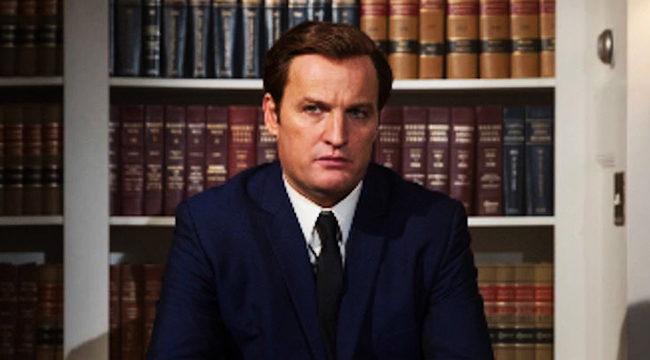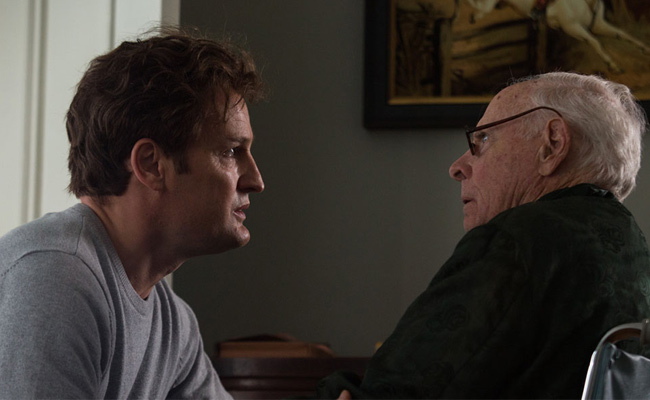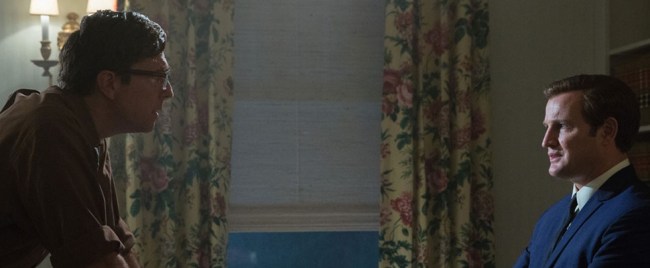
People have been wondering how Mary Jo Kopechne wound up dead in Ted Kennedy’s car under the water off Chappaquiddick Island since the day her body was discovered on July 19th, 1969. Much of that interest surely stems from the fact that Ted Kennedy’s official account of what happened sounded like bullshit. In telling this story on film, whether out of undue reverence for the usual Camelot myths or legal niceties, Chappaquiddick delivers basically the same fishy story Kennedy did all those years ago. …Why? And considering the mystery was a big part of the interest in this even in the first place, in retelling the story we already know (give or take a few stylized sequences here and there, a dramatic moment in a bathtub, a couple dream sequences) there’s a pretty low ceiling on how exciting it could possibly be. It’s a dull story, well dressed.
Aussie actor Jason Clarke (his father was a sheep shearer!) plays Kennedy, his portrayal so subtle and reserved as to be almost pointless. That’s not a knock on Clarke. On paper it’s a reasonable choice, to soft-pedal an iconic character, to avoid turning the easily-parodied er ah Kennedy into some nasally, dropped R chowdah cartoon. It’s easy to imagine that might distract from the story. David Oyelowo similarly underplayed Martin Luther King to great effect in Selma. But in Chappaquiddick there isn’t much to distract from.
Whether or not you think JFK was bogus (and scholarship seems to suggest that large parts of it were), I understand why Oliver Stone wanted to advance his conspiratorial version of the JFK assassination. Much less clear is why director John Curran (Tracks) and writers Taylor Allen and Andrew Logan wanted to tell this almost painfully non-conspiratorial version of the Chappaquiddick incident. Chappaquiddick‘s Kennedy spends most of the movie wrestling with the decision whether to take responsibility for the car accident or to cover his ass. It’s a relevant conflict, between the CYA, admit-nothing mentality (*cough* Donald Trump! *cough, cough*) and true penitence. A movie about public scandal and damage control might be timely. If only we could tell what this Teddy was meant to be taking responsibility for. Driving drunk? Infidelity? Basic negligence? The movie is wishy-washy on all these points and so nothing lands.

Kate Mara plays Kopechne and gets only a couple throwaway scenes, as if the film was even less interested in the actual dead woman than in the basic facts. Ed Helms plays Teddy’s cousin, Joe Gargan, who organized the house party on Chappaquiddick Island, and after the accident quickly becomes the better angel of Teddy’s nature, urging responsibility (whatever that might look like, it’s not really clear). On Teddy’s other shoulder sits his belittling old pa, the famously corrupt city boss and alleged ex-bootlegger, Joe Kennedy (played by Bruce Dern). Disabled by a stroke and barely able to speak, Joe just keeps wheezing out “alibi,” like Darth Vader, if the Dark Side was high-priced lawyers. This piles on a few subthemes, like Teddy being bullied by his overbearing father and overshadowed by his more famous brothers, and Gargan in turn being overshadowed by Teddy. If the damage control theme is relevant, the brotherly rivalry/disapproving father themes range roughly from done-to-death to who gives a shit. (Who among us hasn’t wondered about Joe Gargan’s lady problems?) More importantly, they’re built on a weak foundation.
Understanding why Chappaquiddick‘s facts are so weak requires some background about the incident it purports to depict, so here goes: Ted Kennedy (who was the only eyewitness, for obvious reasons), originally claimed he left a party on Chappaquiddick with Mary Jo Kopechne, a single, 28-year-old former Robert Kennedy campaign staffer, to give her a ride back to the Island’s ferry. He claimed he’d made a wrong turn and drove the car off a bridge, and the car landed upside down in the water. He claimed not to remember how he escaped the car, but that he tried several times to get Kopechne out and couldn’t. He claimed he first walked back to the party and asked for a ride back to the accident spot, where Kennedy, Gargan, and Paul Markham (Jim Gaffigan) all tried to get Kopechne out of the car, once again in vain (all depicted in the film). Kennedy claimed he then swam the 500-foot channel back to his hotel in Edgartown, where he slept through the night and didn’t report the incident until the next morning (explained by way of concussion-addled thinking). It would eventually emerge that Kopechne hadn’t drowned, but suffocated, having apparently found an air bubble inside the submerged car in which the oxygen eventually ran out. That’s an important detail because it took her three or four hours to die and she probably could’ve been saved had Kennedy reported that accident as soon as it happened.
The party they left had been attended by six married men, with none of their wives present, and six single women, all under 30 (the so-called “boiler room girls,” who had worked on the RFK campaign). Kennedy (whose wife was pregnant at the time and confined to bed) always maintained that he was sober at the time of the accident and had been merely giving a friend a lift. Conspiracy theories have understandably abounded ever since, alleging everything from drunk driving to murder.

It’s hard not to develop some opinion about what really happened, but the makers of Chappaquiddick seem to have managed it. Personally, I don’t think it was a murder (though that certainly would’ve made for a more interesting movie), but I also don’t think it’s especially conspiratorial to assume that a guy who’d been at a regatta all day and a party all night had probably had a few, or that a man and a woman who left a party late at night together had some infidelity in mind, consummated or not (if it was merely a ride she was after, Kopechne could’ve used Kennedy’s chauffeur, John Crimmins, who was at the same party).
If Chappaquiddick offered a compelling counter narrative, that’d be fine, but mostly it offers ambiguity — a Ted Kennedy who drinks some and may or may not have been drunk, two characters whose most risqué interaction is to flirt with their eyes. Meanwhile, the biggest departure between Kennedy’s coached statement and Chappaquiddick‘s story is that, in the movie’s version, Kennedy rode to Edgartown in a rowboat paddled by Joe Gargan rather than swam. Needless to say, these are not great stakes on which to frame an intense moral conflict.
For what it’s worth, I always thought the most compelling Chappaquiddick theory was the one put forth in a BBC doc and in a book by Time magazine’s Jack Olsen. That theory goes roughly that Kennedy and Kopechne had left together, likely for a planned tryst at Kennedy’s hotel (Kopechne hadn’t taken her own hotel key with her), but Kennedy got spooked when they saw a deputy (specifically, Deputy Christopher Look Jr, who always maintained that he saw Kennedy and Kopechne in the car together at 12:45, and asked if they needed help and watched them speed off — a moment that’s in the film). After that, according to the theory, Kennedy decided that they should split up, with her taking the car to avoid him being seen late at night with a single woman. Presumably, they agreed to meet up at Kennedy’s hotel. Kopechne then took the car and, being unfamiliar both with Kennedy’s massive Oldsmobile (she was 5’2″ and drove a VW Beetle) and the layout of the island, and possibly partially intoxicated herself, went the wrong way down the road and drove the car off a dock and died.
This version would explain a lot of things, like how Kennedy took such a wrong turn on an island he knew well (though there is official disagreement on this point, about whether he’d never been there before or had been going all his life), how he managed to get out of a car that neither Kopechne nor three other people could open that night, why Kopechne’s injuries were allegedly inconsistent with someone sitting in the passenger seat and, crucially, why Kennedy didn’t report the crash until the next morning. Not being in the car, he didn’t know it happened. As to why he lied, so the theory goes, it was to cover up the attempted affair.
In this version, Kennedy tells a more cockamamie story to cover up an arguably lesser failing (infidelity, perhaps not even consummated infidelity, as opposed to murder, drunk driving, or gross negligence). Maybe it says more about my basic worldview than the evidence that that’s the version I believe. Or maybe it’s too neat for reality, offering logical explanations for all the clues and pat motivations for all the actors. But hey, at least it’s a theory. Chappaquiddick doesn’t even have that.
